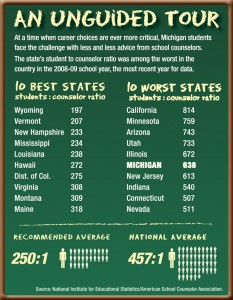Students left with little guidance in high schools
High school seniors are expected to ask their guidance counselors where they can find work in Michigan.
Their guidance counselors, though, may be asking the same question.
At a time when Michigan teens are struggling to find their footing in a changing economy, schools are thinning the ranks of guidance counselors.
State schools averaged one guidance counselor per 638 students in the 2008-09 school year – sixth worst in the nation. And it’s likely gotten worse since then.
"The situation is becoming more and more dire," says Harry Clay, Michigan School Counselor Association manager. "With fewer counselors, they'll have less time to produce. If you don't get a chance to see the kids that often, how effective are you going to be?"
The counseling shortage comes as a Bridge Magazine analysis of job projections concludes that students face very tough competition for jobs for years to come, yet many do not understand the complexities of the job market.
But now, as Michigan school districts contend with statewide cuts, the number of counselors is shrinking even as the state pushes schools to send more graduates on to college.
Each school district decides how to spend its resources, and some have elected to cut a counselor from each middle and high school, or share counselors between schools, while others have cut counselors altogether, Clay said, noting that there is no mandate for a school to hire a single counselor.
"You don't see a math teacher cut as easily as a counselor," he says. "Counselors are less visible on a day-to-day basis, but the job is equally as important."
While the American School Counselor Association recommends one counselor for every 250 students, the ratio in Michigan was one to 638 in the 2008-09 school year, the most recent federal data available via the ASCA.
California was the bottom of the counselor barrel, with one guidance counselor per 814 students; Wyoming was tops with one counselor per 197. (What might make Wyoming's task on counselors easier is the state's sparse population. For example, it had only 88,155 public school students, of all grades, in the 2009-10 school year; just 26,330 in grades 9-12. By contrast, Michigan had just under 1.65 million students in all grades in 2009-10.)
Nationwide, counselor-to-student ratios have been dropping, from an average of 1/588 in 1986-87 to 1/457 in 2008-09.
Recalling a time several years ago when Michigan's student-to-counselor ratio was about 1 for every 450, Clays says the change leaves gaps in service.
 "There will be a lot of complaining on the part of parents, and that might be what will bring some counselors back," he says.
"There will be a lot of complaining on the part of parents, and that might be what will bring some counselors back," he says.
Dennis Brunzell knows he’s fortunate to be one of three counselors at Ypsilanti High School, which expects 950 students this year. But although the ratio is much better than the state average, the school two years ago cut a counselor devoted solely to at-risk students -- and the counseling department secretary. Plus he said cuts elsewhere mean counselors are taking on duties once handled by social workers and others.
The district went from two counselors in each of its two middle schools two years ago to one counselor in its one consolidated middle school last year.
Paperwork and scheduling duties, particularly at the beginning of the school year, tend to trump career/college planning, and academic and personal guidance, says Brunzell, who takes great satisfaction helping students prepare for life after high school.
"We are the ones who go kid by kid, saying, 'Tim needs that second semester of biology or he’s not going to graduate; Suzie needs to get Algebra 2 or she’s not going to graduate,'” he says. "There are kids who fall through the cracks who we catch. If we’re not there, there are so many who will get lost in the system."
In order to ensure success on standardized tests, every emphasis seems to be put on keeping cuts away from the classroom, says Doug Pratt, spokesman for the Michigan Education Association.
"But at what cost?" he asks. "If students don’t have access to a guidance counselor, how can they -- and their families -- navigate the waters of moving on to college? Eliminating positions in all these areas that support student learning and success -- counseling, health, safety, nutrition, transportation, etcetera -- is short-sighted and fails to recognize that student success is influenced in many ways by what happens outside the classroom -- not just within it."
If a guidance counselor has a caseload of 700 students, just slightly above the state average, it would take more than half the school year to see each student for one hour -- if the counselor held back-to-back student meetings every day.
"And in that one hour, it’s almost impossible to develop the relationship and answer the questions needed to help students make these incredibly important life choices," Pratt says.
The Joyce Ivy Foundation published a 2008 Michigan High School Counselor Report, with 22 recommendations for improving the transition from high school to college.
It called for high schools to hire paraprofessionals to absorb the testing and administrative responsibilities currently carried out by professional guidance counselors, freeing these same counselors to devote more time to higher value-added counseling activities with students.
But that was three years before the budget cuts.
Because money will continue to be an issue in Michigan, Executive Director Michael Boulus of the Presidents Council State Universities of Michigan believes secondary education majors should study college counseling.
"I think if we’re going to really do serious college counseling, we may have to push it into the classroom itself and arm our teachers with the information," said Boulus, who worries that many students, particularly in urban and rural areas, don’t have the guidance they need to secure financial aid for college.
Noting that a vast majority of the new jobs created during the next decade will require a college degree, Boulus said Michigan must greatly increase the number of graduates.
That’s part of the reason Boulus is excited about the new Michigan College Access Network. This fall, 32 recent college graduates will be placed in 40 rural and urban Michigan high schools with the sole task of helping juniors and seniors prepare to go on to college.
Eight recent University of Michigan graduates took part in the pilot program last year, working in eight urban Michigan high schools.
The effects were "wildly successful," said Brandy Johnson, the program's executive director.
"We don't have nearly enough high school counselors, and how they have time to do college advising is a huge issue in Michigan," says Johnson. "Counselors are admittedly expensive for high schools to hire because counselors all have master's degrees and often many years of experience. The second issue is that there's little to no coursework dedicated to training counselors in how to be highly qualified college advisers. So often they're relying on their experience when they went to college, which could have been 20 years ago in circumstances that are much different than the young people they're working with."
A principal at one of the eight schools estimated that the number of college applications tripled, Johnson said.
"It's a real game-changer when you have one person whose only job is college advising," says Johnson, explaining that the advisers are not licensed to handle any counseling, nor do they perform administrative tasks.
The U-M program hired more advisers for this year, and Johnson helped start a similar program at Michigan State University, which hired 17 advisers to be placed throughout the state in mostly rural schools this fall. Their salaries will be funded with $255,000 raised in those communities. The Kresge Foundation also is a significant funder.
Following a five-week boot camp, the advisers know pretty much everything there is to know about college admissions and financial aid, says Johnson.
"I'm a first generation college student, and just navigating your way through the informational, logistical and bureaucratic things related to college is a nightmare,” says Johnson. “There's really no one better to help students navigate the process than 22-year-old who just did it themselves four years earlier.”
“We're thrilled that we'll be quadrupling the impact of this corps program within one year."
Bridge Senior Writer Ron French contributed to this report.
Business Watch
Covering the intersection of business and policy, and informing Michigan employers and workers on the long road back from coronavirus.
- About Business Watch
- Subscribe
- Share tips and questions with Bridge Business Editor Paula Gardner
Thanks to our Business Watch sponsors.
Support Bridge's nonprofit civic journalism. Donate today.
See what new members are saying about why they donated to Bridge Michigan:
- “In order for this information to be accurate and unbiased it must be underwritten by its readers, not by special interests.” - Larry S.
- “Not many other media sources report on the topics Bridge does.” - Susan B.
- “Your journalism is outstanding and rare these days.” - Mark S.
If you want to ensure the future of nonpartisan, nonprofit Michigan journalism, please become a member today. You, too, will be asked why you donated and maybe we'll feature your quote next time!


